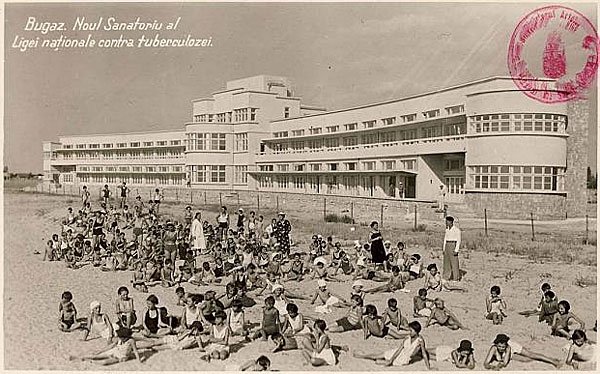
... Many Akkermans know this beautiful building, which spreads its wings next to the bridge across the Tsaregradskoye dirk of the Dniester in the village Zatoka . I'll tell you a little about the history of this children's sanatorium ...
... At all times, tuberculosis has been a dangerous disease that takes millions of human lives. In the Russian Empire, this disease was extremely common. So, in the safe from wars and social upheavals 1911 year 1,016,206 patients were registered.
The organized fight against this disease in the world was started in the late XIX and early XX centuries after the creation and registration of the International League for the Fight against Tuberculosis .
In November 1909 year, the Ministry of Internal Affairs approved the " Charter of the All-Russian League to Fight Tuberculosis ". The sources of the money of the League were membership fees, private donations, contributions of local societies, incomes from the days of _ _ _ _ White Flower , subsidies of city administrations and zemstvos.
The Council of the League discussed the issues of tuberculosis prevention in schools, the treatment of osteoarticular tuberculosis in the sanatoriums at the meetings. Constant tubing for children by this time was 10. For this purpose, special charitable organizations were created that collected funds for their maintenance.
Two children's sanatoriums were established in our locality - Children's shelter-sanatorium in the village of. Budaki name Yeremey Makarovich Yeremeyev - opened in 1904 year and Children's shelter-sanatorium in the locality Bugaz behalf 300th anniversary of the reign of the House of the Romanov , opened in 1914 year. _5 _ _ _ _ _ _ _ _ _ _ _ _ _ _ _ _ _ _ _ _ _ _ _ _ _ _ _ _ _ _ _ _ _ _ _ _ _ _ _ _ _ _ _ _ _ _ _ _ _ _ _ _ _ _ _ _ _ _ _ _ _ _ _ _ _ _ _ _ _ _ _ _ _ _ _ _ _ _ _ _ _ _ _ _ _ _ _ _ _ _ _ _ _ _ _ _ _ _ _ _ _ _ _ _ _ _ _ _ _ _ _ _

The word " Bugaz " in Turkic languages means "mouth, throat".
From the beginning of the 20th century, the territory near the Tsaregrad estuary of the Dniester began to be intensively developed for recreation purposes. Even in 1903 year were marked out the country plots for sale. The first to acquire a site and immediately built a summer residence in 1904 year attorney Skalsky.
The Bessarabian Bugaz was marked by four rows of dachas at a distance of three versts. In the year of 1914, 32 dachas of owners were already built, about two dessiatines were reserved for the future trading area, almost three tithes for the steamer pier, two tithes for the Akkerman shelter "Yasli" and ten dessiatines for the sanatorium of the Society of Moscow Orphanages ".
In August 1913 of the year the Highest Ordinance was issued on the establishment of a sanatorium on Bugaz:
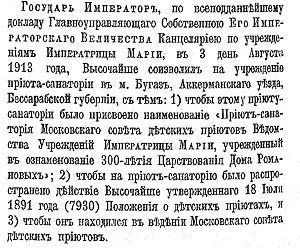
The poor, sick and weak children of the Moscow hospital named after Emperor Alexander III were resting and improving their health at the sanatorium on Bugaz ".
Founded in 1896 year, the Society of Moscow Children's Shelters was part of the Office of the Empress Maria, established for the centralized management of special institutions for the charity of children throughout Russia.
At the end of the century, besides the two educational buildings in Moscow and St. Petersburg, the Office of the Empress Maria had more than 300 shelters, nurseries and schools, about 150 educational institutions and 4 educational institutions.
All institutions of the Office obtained funds for charitable work independently. Their main sources were membership fees in grassroots organizations, gifts of individual benefactors, interest from capital, income from charitable events.
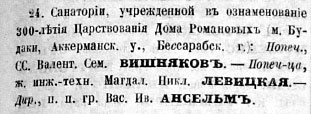
The trustees of the Sanatorium were the State Councilor Valentin V. Vishnyakov - Member of the Management Board of the Moscow Commercial Institute, a member of the progressive group of the City Duma's vowels and Levditskaya Magdalina Nikolaevna - woman engineer in the Akkerman uyezd office, the wife of Akkerman City architect Levitsky Marian Karlovich.
The director of the sanatorium was a hereditary honorary citizen, an honorary world judge Anselm Vasily Ivanovich , a descendant of Swiss settlers from the colony Shabo .
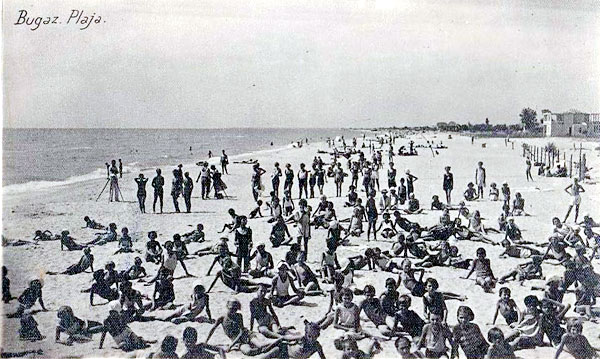
Training in children's shelters was carried out in accordance with the recommendations of the Ministry of Education. In addition to studying the Law of God, the Russian language and arithmetic, children learned to write, draw, gymnastics and choral singing. It should be noted quite humane methods of education in children's shelters. Here corporal punishments were forbidden and methods such as censure, explanation of incorrectness of actions were used. As a last resort, a reprimand was pronounced.
The content and forms of educational work were varied: games, gatherings, fishing, participation in the choir, etc. were used. Children were on duty in the kitchen, cleaned the rooms, washed linen, practiced needlework, worked in the hospice gardens and gardens, trained in crafts.
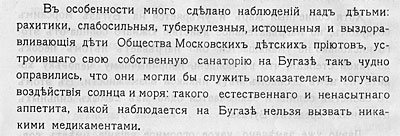
_1 Unfortunately after the First World War and social cataclysms the sanatorium ceased to function ... Romanian Bugaz became a border point ...
...
20 years have passed. Gradually, relations between Romania and the Soviet Union were normalized. At the end of the 20's years on the initiative of the Chamber of Commerce g.Chetatya-Alba (former Ackerman) in the village was restored Bugaz seaport and let down the asphalt road.
Black Sea resorts in Romania began to develop. The king decided to turn the sea coast of Bessarabia into Romanian Baden-Baden.
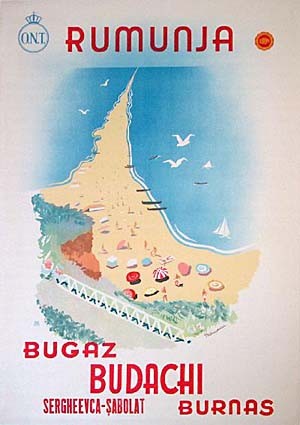
In 1930 -x's League of Nations Health Organization has initiated the construction of a tuberculosis sanatorium in the resort Bugaz on the Black Sea coast near the border with the Soviet Soyuzom.Proekt resort has been prepared on request of the League of Nations Health Organization, and was carried out on its means to help Romania in the fight against tuberculosis.
The project was ordered to the architect Angelo Viecelli (1884-1948), who created in the style functional Art Deco , fashionable in the 30s. Among his famous works - the hospital "Regina Maria" in Balchik (Dobrudja) and the project of the Sanatorium Carmen Silva (1936).
The building of the sanatorium was built during 1933-1934 years.
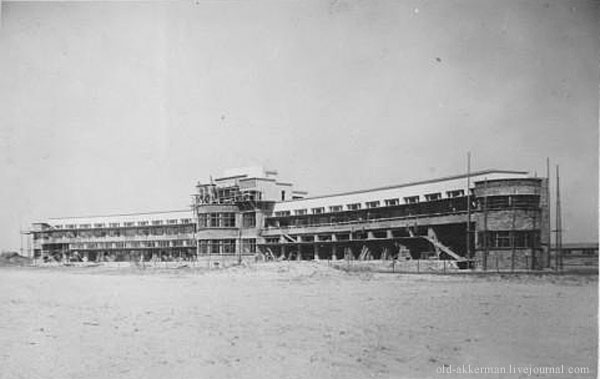
The sanatorium was intended for children and saved its specialization to our time. It consists of the main symmetrically placed volumes and an additional wing attached to the right, which was built somewhat later.
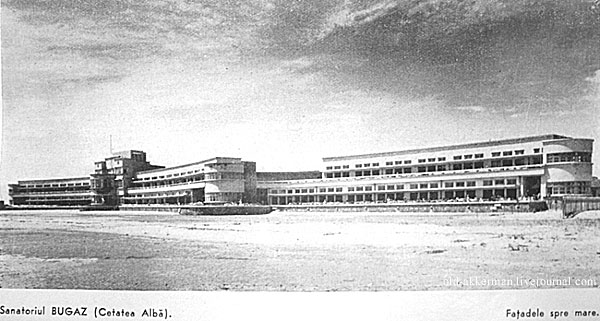
The building of the sanatorium is a bit like an airplane, the central high volumes resemble a fuselage, and the long crescent-shaped wings remind the wings of an airplane. The main façade faces the shore, and the additional wing does not spoil the general view, because it is located at an angle to the main building and thus from the shore one can see either the wing or the main building. The wings of the building in the horizontal direction are drawn with long cornices and balconies creating intersections with numerous short vertical lines of windows, the central part according to the requirements of Art Deco towers over the entire structure.
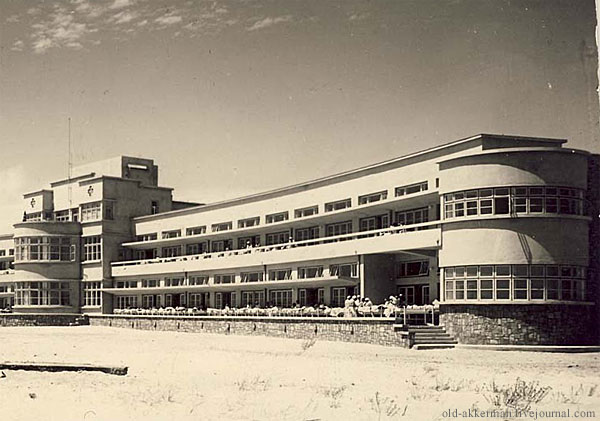
Therapeutic and diagnostic departments, pharmacy, operating room, school premises, food station, are designed in a 3-storey building of the medical building facing the sea, south. Separately, there were reception rooms, an insulator, residential buildings and outbuildings. The architecture and layout of the main medical building is unique and met all the requirements for the treatment of patients with osteoarticular tuberculosis.
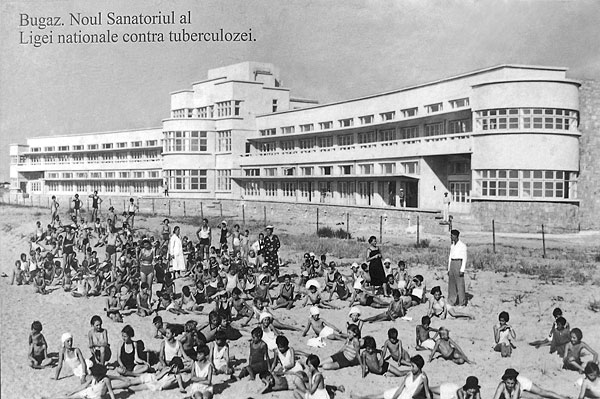
June 10 1937 of the year the official opening of the sanatorium took place in the presence of King Carol II and his wife Elena. The first arrival of patients and payment of treatment were made at the expense of the queen. Subsequently, the patients were treated privately and the treatment was usually paid for at the expense of municipal funds at the place of residence of the patients.
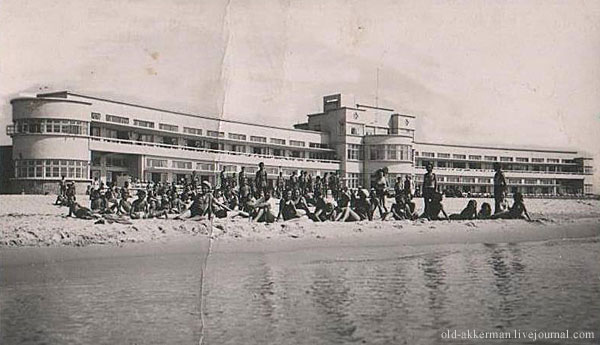
Treatment of osteoarticular tuberculosis was lengthy and costly. Typically, the treatment was accompanied by a prolonged immobilization with gypsum products with maximum use of climatic factors due to the extensive verandas facing south and communicating with the chambers. Much attention was paid to rational nutrition. Bunks were on wheels, as almost all patients were in strict bed rest and consequently there was no need to shift patients in medical manipulations and procedures.
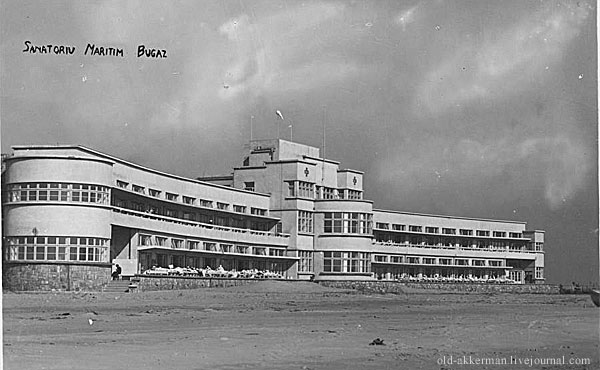
The main doctor of the sanatorium was ATANAS Janosh , a Hungarian by nationality. A man of progressive views, he headed the sanatorium since its foundation. Periodically, he trained in leading European clinics. Economic functions carried out by the director, who was in his direct submission. In the sanatorium there were also two heads of departments, who permanently resided on the territory of the sanatorium and two assistant doctors who came to work daily from Akkerman. In the hostel of the sanatorium there were about 40 nurses. The junior medical and economic personnel were recruited from the local residents of the district. Nutrition for employees was compulsory and was carried out at the expense of the sanatorium.
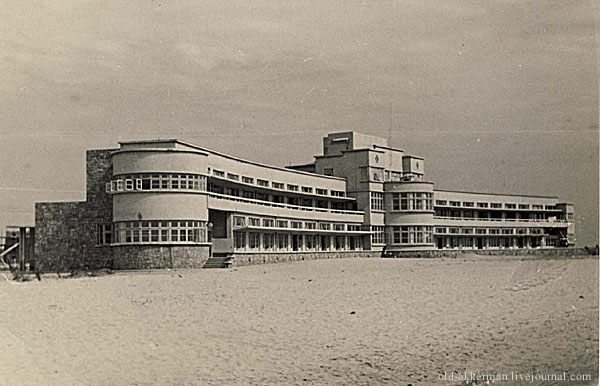
_ _ _ _ _ _ _ _ _ _ _ _ _ _ _ _ _ _ _ _ _ _ _ _ _ _ _ _ _ _ _ _ _ _ _ _ _ _ _ _ _ _ _ _ _ _ _ _ _ _ _ _ _ _ _ _ _ _ _ _ _ _ _ _ _ _ _ _ _ _ _ _ _ _ _ _ _ _ _ _ _ _ _ _ _ _ _ _ _ _ _ _ _ _ _ _ _ _ _ _ _ _ _
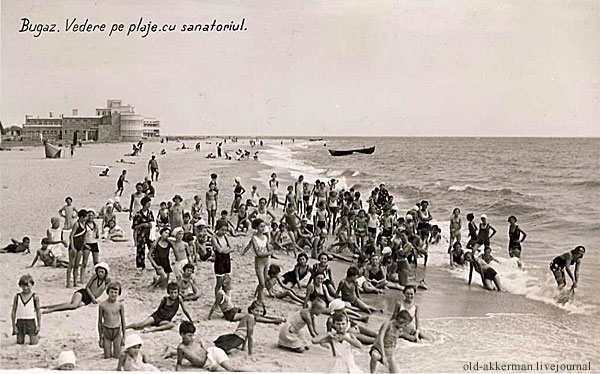
In August 1940 years after the reunification of the Ishmael region with Ukraine, the resort Bugaz with all movable and immovable property passed to the main resort management of the People's Commissariat of Health of the Ukrainian SSR. Some of the patients were evacuated to Romania at their request . Sanatorium "Zatoka" became a children's osteoporosis sanatorium and for the first time accepted children from all over Ukraine for free treatment.
In June 1941 years the children were evacuated in Odessa in the sanatorium. Chkalov, that on the French Boulevard, in which they were until August or September 1941. Then the ship "Crimea" sent them to Tuapse, and then by train to Maikop, where they were until the end of October 1941. After that, they were evacuated by train to the Abkhaz ASSR in Gagry (Old Gagra), to the tuberculosis sanatorium "UKRAINE", where they were until the end of August 1942. After they were driven by cars to New Gagry, where the tanker "Stakhanovets" was sent by sea to Sukhumi. There they were placed in the seaport, where most children received food poisoning as a result of eating spoiled chicken and were sent to the city hospital. Then the children were again evacuated: from Sukhumi to Baku by steamer "Tsuryupa", then to Krasnovodsk, by train to Semipalatinsk, then to the East Kazakhstan region, the city of Shemonikha, the bone-tuberculosis sanatorium "Ukraine", where they were from November 1942 to July 1944 . From 1944 to October 1945 - the South Kazakhstan region, the Chulkubas district, the Sastyube station, the Balichi village, and the Ukraina sanatorium. After, in October 1945, they were sent to Kiev, the hospital to them. Kalinin, and then in the Odessa region, the village of Kholodnaya Balka, the sanatorium. October revolution. After treatment, many children were sent to orphanages.
In 1944 year Romanians created a strong fortification in the village of Bugaz. Basically they kept the defense in the building of the tuberculosis sanatorium, a strong building in 4 floors.
On the night of 21 on August 22, 1944 parts of the Danube Military Flotilla participated in the Dniester landing operation (crossing the Dniester estuary). Part of the forces participated in the breakthrough from the sea to the Tsaregrad girlo.
The main medical building and a number of auxiliary buildings and services were significantly damaged and partially destroyed , and property - plundered. At the first floor of the medical building at one time there were stables. All the equipment of boiler house, water supply, sewerage, power plant and central heating system was dismantled and taken out. Separate iron-concrete ceilings and walls were smashed by shells. The roofs of the medical and residential buildings were damaged.
Due to military adversities and post-war devastation and deprivation, the incidence of all forms of tuberculosis in particular increased sharply among the population. During this period, there was a huge need for bone-tuberculosis beds, especially for children and adolescents.
Therefore, after the war, in 1946 year the rehabilitation of the sanatorium began. In _2 _ 1947 year the sanatorium functioned only for 50 beds. And already in 1948 year the number of beds in the sanatorium was brought to 475.
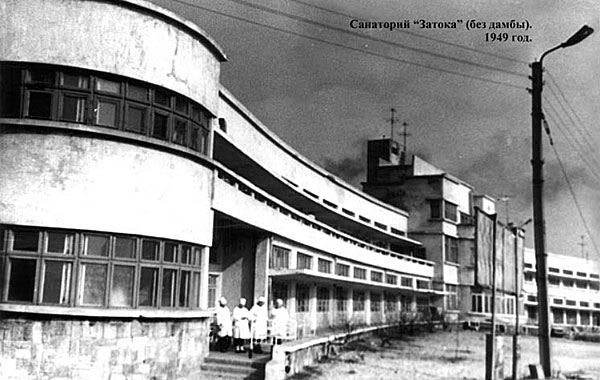
Photo from the site old-akkerman.com.ua
In 1954 year the capacity increased to a maximum of 515 beds in winter and 680 in summer. In the sanatorium there were 5 offices constantly and one seasonal in the summer. Naturally, such an increase in the number of constantly functioning beds, could not but lead to the disregard of any hygienic rules and norms. However, despite the difficult conditions of the sick, the sanatorium has made significant progress in setting up medical work.
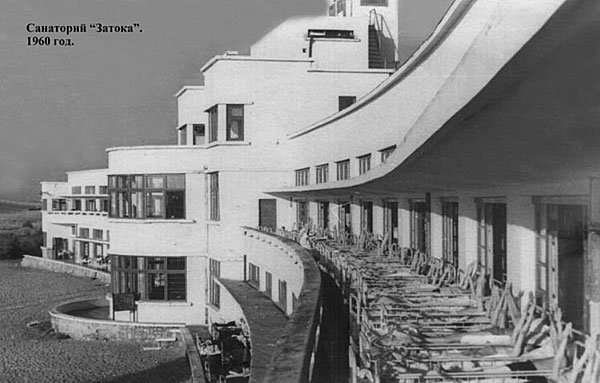
Photo from the site old-akkerman.com.ua
In the post-war period, a huge work was done by the sanatorium. More than 35,000 patients have been discharged, mainly with excellent and good results. From 1948 to 1985, more than 3,000 operations were carried out.
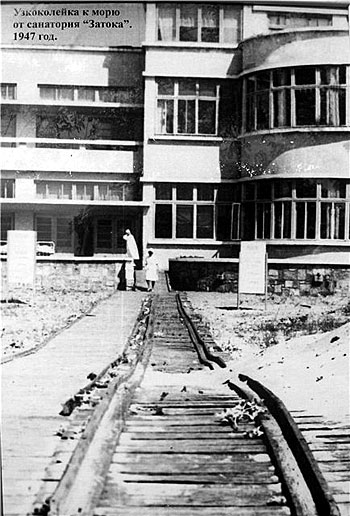
Despite the fact that the capacity of the sanatorium was maximized, auxiliary services and improvement of the sanatorium needed a radical improvement. On the territory of the sanatorium remained dilapidated buildings, boiler house of central heating and water supply did not ensure the full extent of the sanatorium. Electricity was produced by the engine. In April 1967 of the year, a 500-kV power transmission line was put into operation. Since that time, the sanatorium has moved to a centralized power supply with complete electrification of the facilities. In 1970 year new X-ray equipment was purchased and installed.
In the 1960s the sanatorium in Zatoka was part of the border zone, a pass was required to enter the territory.
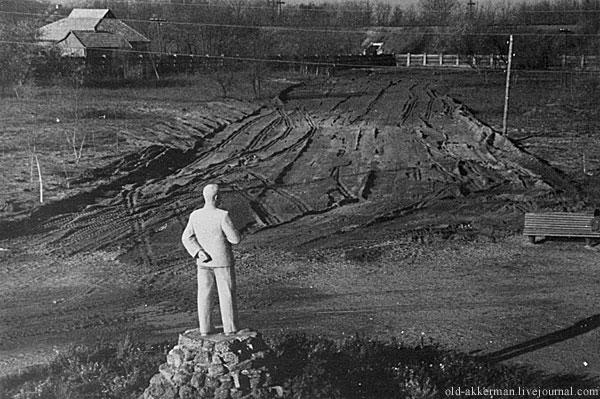
For the improvement of the ecological situation in the sanatorium, a centralized boiler house and a heating main have been built with the help of the Village Council. Two artesian wells were reconstructed and constructed, which completely provided the sanatorium with good quality water. On the territory of the sanatorium, playgrounds and detachments were equipped. The capital of the main medical building, residential buildings and services was twice repaired.
Already in the 90s two dining rooms for 200 seats were built in the sanatorium, capital repairs of treatment facilities were completed, a vegetable storehouse and a reading room of the school library were built.
Now the sanatorium is called "Children's specialized sanatorium" Zatoka ".
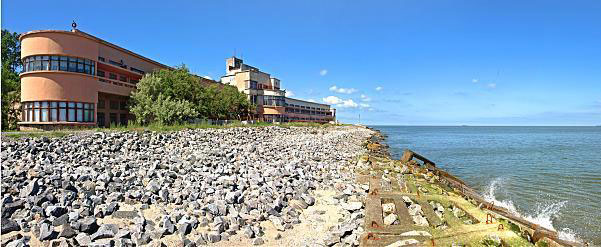
In October 1980 of the year, as a result of uncontrolled sampling of sand from the coastal zone, the bank dam was eroded, built in 1966 year by the port of Illichivsk by the decision of the courts. _5 _ _ _ _ _ _ _ _ _ _ _ _ _ _ _ _ _ _ _ _ _ _ _ _ _ _ _ _ _ _ _ _ _ _ _ _ _ _ _ _ _ _ _ _ _ _ _ _ _ _ _ _ _ _ _ _ _ _ _ _ _ _ _ __ _ _ _ _ _ _ _ _ _ _ _ _ _ _ _ _ _ _ _ _ _ _ _ _ _ _ _ _ _ _ _ _ _ _ _ _ _ _ _ _ _ _ _ _ _ _ _ _ _ _ _ _ _ _ _ _ _ _ _ _ _ _ _ _ _ _ _ _ _ The work was completed in 1983 year under the supervision of the Odessa anti-slump control.
At the present time and this is actually the second bank protection structure that was half destroyed, it requires immediate restoration. Some works to strengthen the dam could be done in 1995-1996 years at the expense of funds allocated by the State Administration in emergency order. Unfortunately, the measures taken are clearly not enough, and repeated appeals to the Ministry of Finance and the Cabinet of Ministers of Ukraine did not find support and in carrying out the restoration work in 1997 year, the sanatorium was categorically denied.
Now the sea waves splash just a few meters from the main building of the sanatorium.
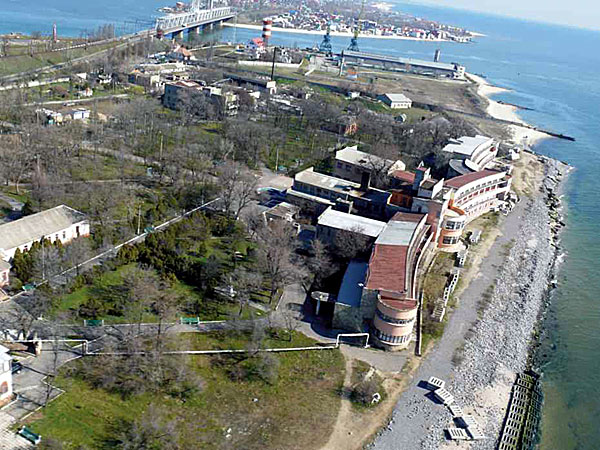
The building of the sanatorium is one of the largest buildings of Romanian time in our locality and at the same time is one of the best sanatoriums in Ukraine relating to functional architecture.
The sanatorium has been assigned a conservation status: an architectural monument of local significance (Resolution No. 807-a of 31.12. 1996 r.).
 Glyanec
Glyanec